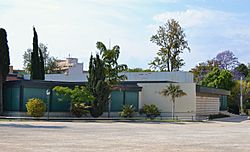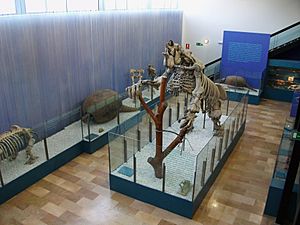Natural Science Museum of Valencia facts for kids
| Museo de Ciencias Naturales | |

Exterior of the Natural Science Museum.
|
|
| Established | 1999 |
|---|---|
| Location | Avenida del General Elío, s/n (Jardins del Real), Valencia, Spain. |
The Natural Science Museum in Valencia, Spain, is a cool place to explore the natural world! You can find it in the beautiful Jardines del Real, which is like a big park in the city. It's a fantastic spot to learn about ancient animals and the amazing variety of life on Earth.
Contents
How the Museum Started
The Natural Science Museum of Valencia began a long time ago, in 1889. Back then, it was called the Palaeontological Municipal Museum. It started thanks to a very generous engineer named José Rodrigo Bolet.
José Rodrigo Bolet's Amazing Collection
José Rodrigo Bolet was born in Manises, Spain. He moved to Argentina in 1875, where he worked on big building projects. While there, he collected an enormous number of fossils.
On July 14, 1889, he sailed from Argentina with his huge collection. It arrived in Valencia on August 9, creating a lot of excitement! His collection included many mammal fossils from the Quaternary period in South America. The most famous fossil was a human skeleton called Samborombón.
Early Days and New Homes
When the museum first opened, it was in an old building called San Gregorio's Convent. A person named Enrique De Carles helped set up the skeletons.
In 1890, the collection moved to a municipal building on Ruzafa Street. Later, in 1896, it moved again to an old Jesuit building, San Pablo's Hospital.
A New Director and Public Opening
José Rodrigo Botet, who donated the collection, passed away in 1904. Eduardo Boscá Casanoves became the first director of the museum. He was a senior gardener at the Botanical Garden and believed strongly in evolution. He worked with Carlos Maicas to continue setting up the skeletons.
In 1902, the city wanted to show the collection to everyone. The San Pablo's Hospital building wasn't good enough. They planned a new building, but it was never built because there wasn't enough money.
Instead, the collection moved to the Almodí building. This was an old corn exchange from the 14th century, right in the heart of Valencia's historic area.
Opening to the Public
The new location allowed the public to visit the museum. It officially opened in 1908 as the Municipal Museum of Paleontology.
Eduardo Boscá Casanoves, the first director, passed away in 1924. Francisco Beltrán Bigorra took over. He added a huge collection of seashells (malacological collection) donated by Eduardo Roselló Bru in 1925.
Moving to the Current Location
The museum stayed in the Almodí building for many years. But in 1989, heavy rains damaged the building badly. The collection had to be moved quickly because the building was unsafe. This was a huge move, one of the biggest in Europe since World War II!
The collection was first moved to the ground floor of the town hall. It opened there on July 2, 1991.
In 1996, the city decided to create the current Natural Science Museum. They chose to use an old restaurant building called Restaurante Viveros. The goal was to make the museum more educational and modern. Finally, in 1999, the current Museum of Natural Sciences of Valencia opened its doors. It's in the same spot where they had planned to build the Valencian Palace of Natural Sciences at the beginning of the 20th century!
The Museum Building
The building where the Natural Science Museum is located today used to be a fancy restaurant called Restaurante Viveros. It was built in the late 1950s. The architect, Luis Gay, was inspired by a famous architect named Ludwig Mies van der Rohe. This building is considered very special and is a protected historical site.
What You Can See: Collections
The museum has some amazing collections!
Rodrigo Botet's Fossil Collection
José Rodrigo Botet's collection is one of the best in Europe for fossils from the Pleistocene period in South America. It includes twenty full skeletons and more than five thousand bones! These belong to over twenty different mammal families.
Museum Galleries and Exhibits
The museum has several exciting rooms and exhibits:
- Science and Technology: This room shows the history of science. You can see Valencia's first electronic microscope, bought in 1966. There's also a recreated 19th-century science lab, like the one Santiago Ramón y Cajal might have used.
- Biodiversity: Learn about the amazing variety of plants and animals in Valencia. You can even take a virtual tour of natural areas like El Saler and La Devesa.
- Origin of Life: Explore the very beginning of life on Earth, focusing on the Paleozoic era.
- Rodrigo Botet Paleontological Collection: This is where you'll find the museum's most impressive display! The star is a complete skeleton of a six-meter-long Megatherium, a giant ground sloth. You can also see skeletons of a huge bear, a saber-toothed tiger (Smilodon populator), and several giant armadillos like Eutatus seguini and Glyptodon clavipes. These fossils were even mentioned by Charles R. Darwin in his famous book, The Origin of Species!
- Mesozoic and Cenozoic: Travel through time to the eras of dinosaurs and early mammals.
- Dinosaurs of the Valencian Community: Discover the dinosaurs that once roamed where Valencia is today.
- Sites of the Valencian continental Neogene: See a 5-million-year-old skull of a dugong-like animal called Metaxytherium, found in Pilar de la Horadada.
- Malacology: This room displays a part of the seashell collection donated by Eduardo Roselló Bru in 1925.
- Ecosystems and city birds: Learn about different natural environments and the birds that live in cities.
- Beekeeping: Discover the fascinating world of bees and honey production.
- Temporary exhibitions: The museum also hosts special exhibits that change over time.
Main Areas to Explore
The museum is divided into four main areas:
- Valencia's Role in Natural Sciences: Learn about important contributions from Valencian scientists.
- The History of Life: Take a journey through Earth's different time periods. This area also features the amazing Rodrigo Botet fossil collection, including the famous Megatherium.
- Malacology: See an interesting collection of mollusk shells, showing the variety of seashells found in the Valencian Community.
- Valencian Ecosystems: Explore the rich and diverse natural environments around Valencia. It's amazing how a city with almost a million people can have a river, the sea, farms, and important natural areas like the Parc Natural de l'Albufera de València (Valencian Albufera Nature Park), including the Albufera lagoon and the Devesa forest.
See also
 In Spanish: Museo de Ciencias Naturales de Valencia para niños
In Spanish: Museo de Ciencias Naturales de Valencia para niños




